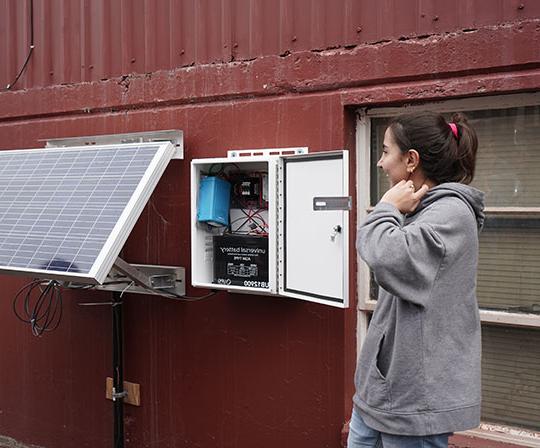Alfred University ‘Tiny House’ on display during National Solar Tour

Nearly 120 people, including approximately 50 students and teachers from four area high schools, visited Alfred University’s “Tiny House,” on display on during the National Solar Tour held over the weekend.
The 28th annual National Solar Tour, held at various locations across the country Oct. 6-8, was sponsored by the American Solar Energy Society (ASES), a leading solar energy non-profit advocacy group. The Solar Tour features projects—which can be viewed in person or virtually—which promote sustainability. The event features not just solar energy initiatives, but a host of others which promote sustainability, including electric vehicles, water harvesting and conservation, mechanical heating and cooling, and other, non-solar sources of electric power generation.
The event included virtual and in-person visits to Alfred University’s Tiny House, a project which began six years ago as a capstone project for three renewable energy engineering majors. In the years that followed, other renewable energy engineering students worked on other features of the tiny house as part of their capstone projects.
Solar Tour-related activities at Alfred University included morning and afternoon informational sessions. The sessions included presentations by physics professors Connor Robinson and Roger Loucks, who discussed solar energy; Alfred University Office of Admissions, with new director Kyla Whannell; posters on solar energy and the Tiny House, used in Alfred University’s AU Energy Symposiums in 2018 and 2019; and a talk by Junpeng Zhan, assistant professor of renewable energy engineering.
Dan Lu, associate professor of renewable energy engineering gave a presentation on the solar energy simulator housed in Seidlin engineering annex. The simulator measures the energy harvesting capabilities of photovoltaic (PV) cells designed and built by renewable energy engineering students.
Alfred University students Hunter Williams and Elise Wardour (junior renewable energy engineering majors) and Jasmine Willard (senior renewable energy engineering major) lead public demonstrations of the Tiny House features, which includes a solar-generated power system.
Imran Tutul, a graduate student in electrical engineering, and Sara Karimi, a graduate student in mechanical engineering, facilitated discussions on off-grid solar power.
“I thought the event was very successful,” remarked Xingwu Wang, professor of electrical engineering and renewable energy engineering. “The students and teachers were particularly excited about the experience.”
High school; students and teachers from Alfred-Almond, Cuba-Rushford, Whitesville, and Genesee Valley were among those in attendance. Others visiting Tiny House were family and alumni on campus for Homecoming/Fall Family Weekend.
Wang explained that Alfred University’s Solar Tour activities were effective because they included interaction between visitors and University students, staff, and faculty, which included demonstrations of how solar energy systems work. “It’s much easier to understand when you have visuals, as opposed to just reading about it in a book.”
Construction of the Tiny House at Alfred University dates back to the fall of 2017, when students Matt Finley, Zach Mapes and Seneca Collins proposed it as the capstone project for their bachelor’s degree in renewable energy engineering. Finley, Mapes and Collins earned their degrees in 2018. Finley and Mapes went on to earn MBA degrees from Alfred University, in December 2018 and 2019, respectively.

During the 2017-18 academic year, students from Alfred University as well a group of students from Alfred State College majoring in building trades, constructed the frame for the walls, floor, and roof of the tiny house, which was then mounted on a 24-foot trailer chassis. Nearly 30 Alfred University students—from a wide array of academic programs including renewable energy engineering, mechanical engineering, fine arts, ceramic engineering, environmental studies, marketing, and counseling—took part in the initial build at Alfred State’s Wellsville campus.
That year the Tiny House was featured at the Alfred University-hosted AU Energy Symposium, which was attended by numerous representatives of the power industry. Students presented drawings of what the house would look like throughout its construction through completion.
Capstone projects utilizing the tiny house in ensuing years included installation of a hot water tank and water collection and filtration system; installation of the solar PV system—solar panels were mounted on the house’s roof—which generates power that can be stored in a lithium-ion battery bank; and outfitting the house with an automated system for remotely controlling the tiny house’s electricity usage.
The interior design of the 200 square-foot tiny house includes a loft for sleeping quarters; a kitchen area with a stove and small refrigerator; a sitting area; and a small bathroom which includes a compost toilet. Wang said the goal is to sell tiny house once it is complete, which he says should be in the fall of 2024. Future projects include installation of a “green wall,” a garden mounted on an outside wall consisting of a network of planters in which vegetables can be grown; insulation and a heating system; and a folding exterior deck.
Last spring, Alfred University’s Information Technology Systems Department installed ethernet service to the house so that solar power generation and usage can be monitored remotely.
Wang this week submitted a call for proposals for painting a mural on an exterior side of the Tiny House. Submissions of proposals are due Oct. 27 and can be submitted to Wang via email at [email protected]. The mural should be solar themed and needs to be completed before January 2024.
